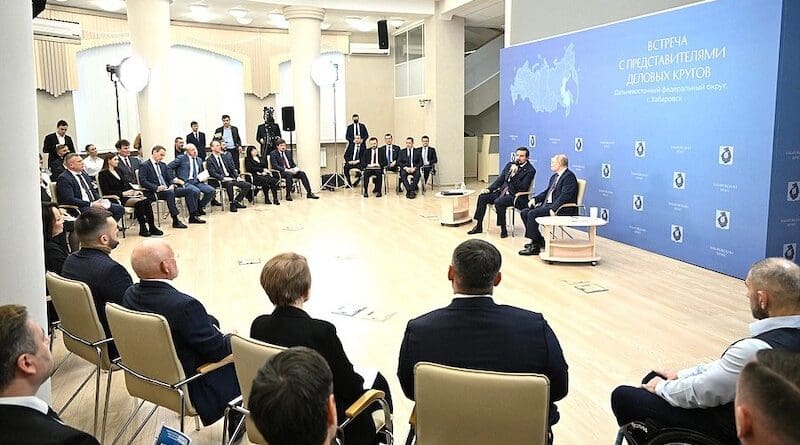Significance Of Putin’s Far East Trip – OpEd
Undeterred by the chilly frosty weather, Russian President Vladimir Putin made a quick working trip to the Russia’s Far East cities including Chikotka. Putin’s main concern was to get first-hand acquainted with the stage of development in that region and, with the forthcoming presidential election to make an informal political engagement with the inhabitants in the Far East. Putin visited Khabarovsk last time more than a decade ago – on December 31, 2013 after the flood in the Far East. He, then, delivered his New Year message from there.
While staying in Anadyr, Putin visited an all-year-round greenhouse facility owned by the Makatrov family and was shown its produce. Self-employed entrepreneur Natalya Makatrova acted as the President’s guide. The enterprise, which is a resident of the Chukotka priority development area, began the first stage of its operations in 2017. Modern farming makes it possible to grow vegetables in permafrost conditions, providing a supply to regional kindergartens and schools. The new greenhouses feature a weather station, a heating, ventilation and air conditioning (HVAC) system and automatic sprinklers.
Most difficult stage of development of Russia’s Far East over, noted Putin, summing up the results of his trip to Chukotka and the Khabarovsk Region, the Russian leader recalled that the authorities are implementing a large program for the development of the Far East. “And it is multidirectional, and there are results. We will certainly continue to work on all these issues. I really hope that people will feel it,” the president said, referring to Chukotka and the Khabarovsk regions.
Putin’s trip to the Chukotka Autonomous Area ended with a meeting with the local Governor, Vladislav Kuznetsov, who reported on the region’s economic performance. The Governor also talked about fish processing, housing construction and creating logistics hubs in the key cities along the Northern Sea Route, as well as staffing healthcare institutions, especially with doctors, medical specialists, building sports infrastructure, and ensuring online connectivity across the Chukotka Autonomous Area.
On January 9, the Russian government approved long-term plans for the comprehensive socio-economic development of 16 Far Eastern cities through 2030. The master plans for these cities provide for the renewal of housing stock, the construction of social facilities, landscaping, modernization of transport and utility infrastructures, and the development of resort areas.
Putin held a detailed conversation with the local business community, viewed a presentation of comprehensive development plans for Far Eastern cities, visit a local animated cartoons studio and interacted with Khabarovsk Territory Governor of the Region Mikhail Degtyarev.
During his meeting in Khabarovsk with business leaders from the Far Eastern Federal District, Putin stressed the development of the shipbuilding industry and spoke about the regional economy. “Apparently, with all the external pressure on Russia, the attempts to constrict us, we have become the biggest economy in Europe, overtaking Germany, and fifth in the world after China, the United States, India, and Japan. We are number one in Europe,” he said at the meeting.
“Like many European economies, Japan is a high-tech economy. We have overtaken every European economy in terms of purchasing power parity, but not yet in per capita terms. We will have to work more on this,” he added.
Khabarovsk Territory Governor Mikhail Degtyarev said during a presentation to the Russian president of master plans for the development of Khabarovsk and Komsomolsk-on-Amur at Pacific National University. According to the governor, the local extractive industries have shown a slight decline but the region’s trade has picked up, showing growth of 5.5 percent in 2023. Economic growth is also confirmed by energy consumption. For the first time since Soviet times, the region reached a maximum 1.7 gigawatts as of December 22, 2023.
Degtyarev also noted that the Far Eastern Auto Cluster would become the core of the Southern Economic Zone of Khabarovsk. Investment is on the rise. The Malmyzhsky copper concentrate mining and processing facility will be launched this year; the Pacific Railway – a unique project to build tracks from the Elga coal deposit in Yakutia to the Port Elga sea coal terminal with private investment – is in progress, with 280 out of 500 kilometres of track already built.
The first berth is competed and ready to handle a test bulk carrier this year. Russian Railways and their contractors are also making active progress on the second stage of the Eastern Operating Domain project, which is very important for the region’s economy.
Degtyarev also spoke about support for small businesses, housing construction, including rental housing, and the region’s involvement in various education-related projects. Comprehensive plans have been prepared for Anadyr, Arsenyev, Birobidzhan, Blagoveshchensk, Belogorsk, Bolshoi Kamen, Vladivostok, Komsomolsk-on-Amur, Krasnokamensk, Neryungri, Nakhodka, Magadan, Ussuriysk, Svobodny, Khabarovsk and Yakutsk.
What is popularly called the Russia’s Far East is the vast easternmost part of Russia and the Asian continent, and is administered as a part of the Far Eastern Federal District, which is located between Lake Baikal in eastern Siberia and the Pacific Ocean. According to the 2021 Census, the Far Eastern Federal District had a population of 7.98 million. Most of it is concentrated in the southern parts.
The area’s largest city is Khabarovsk, followed by Vladivostok. The region shares land borders with the countries of Mongolia, China, and North Korea to its south, as well as maritime boundaries with Japan to its southeast, and with the United States along the Bering Strait to its northeast. Although the Russian Far East is often considered as a part of Siberia abroad, it has been historically categorized separately from Siberia in Russian regional schemes (and previously during the Soviet era when it was called the Soviet Far East).

